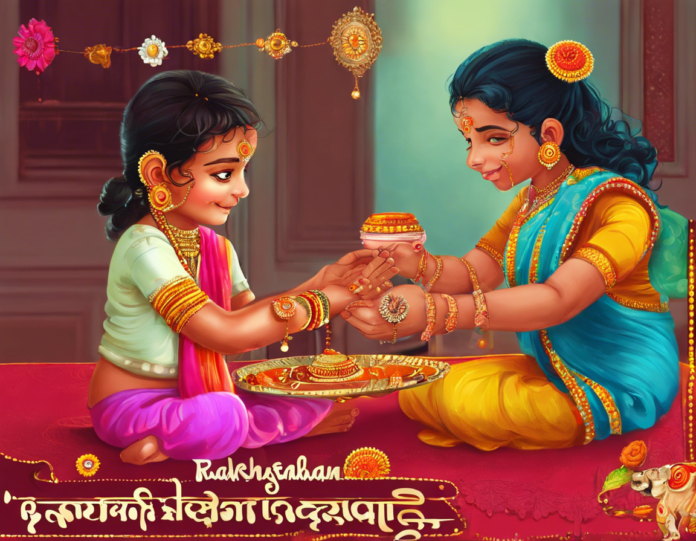Rakshabandhan, also known as Rakhi, is a significant Hindu festival that celebrates the bond between brothers and sisters. The word “Rakshabandhan” is derived from Sanskrit, where “Raksha” means protection, and “Bandhan” means to tie or bond. On this day, sisters tie a sacred thread, known as Rakhi, on their brothers’ wrists, symbolizing love, protection, and the bond of duty between siblings. In return, brothers pledge to protect and take care of their sisters.
Significance of Rakshabandhan:
Rakshabandhan holds immense cultural and emotional significance in Hindu tradition. It is a day to strengthen the bond between siblings and pray for each other’s well-being. The festival transcends biological relationships and is also observed between cousins, friends, and sometimes even neighbors who consider each other as siblings.
Date and Timing:
Rakshabandhan is typically celebrated on the full moon day in the Hindu month of Shravan, which usually falls in July or August according to the Gregorian calendar. The auspicious timing for tying Rakhi, known as “Rakhi Muhurat,” is considered important for the ritual to be most effective and bring prosperity and blessings to the siblings.
Auspicious Timing – Muhurat:
The auspicious period for tying Rakhi varies each year based on planetary positions and astrological calculations. It is believed that performing the ritual during the most auspicious time enhances the positive effects of the ceremony. The Muhurat for Rakshabandhan is determined based on the Tithi (lunar day), Nakshatra (constellation), and the alignment of planets.
Factors to Consider for Muhurat:
- Tithi: The Tithi on Rakshabandhan should be the full moon day (Purnima) in the month of Shravan.
- Nakshatra: The presence of specific Nakshatras like Shravana, Rohini, Mrigashira, Ardra, and Pushya during the Rakhi Muhurat is considered auspicious.
- Planetary Positions: The alignment of planets, especially the Moon, Mars, and Jupiter, plays a crucial role in determining the auspicious timing for Rakhi tying.
Importance of Muhurat in Rakshabandhan Rituals:
The Muhurat is significant as it is believed to align the ceremony with the positive cosmic energies, ensuring the success and longevity of the bond between siblings. The Rakhi Muhurat is a time when the Earth’s energy field is conducive to enhancing the protective and nurturing aspects of the relationship between brothers and sisters.
How to Determine the Muhurat for Rakshabandhan:
To determine the Muhurat for Rakshabandhan, individuals can consult Hindu calendars, priests, or astrologers who specialize in Muhurat calculations. These experts consider the planetary positions, Nakshatras, and Tithi to identify the most auspicious time for tying Rakhi. It is advisable to start the preparations in advance to ensure everything is ready for the sacred ceremony.
Celebrating Rakshabandhan:
On the day of Rakshabandhan, sisters perform aarti (ritual of waving lighted wicks in front of deities), apply tilak (vermillion mark) on their brothers’ foreheads, tie the Rakhi on their wrists, and offer sweets. Brothers, in turn, give gifts to their sisters as a token of their love and promise of protection. The day is filled with joy, love, and familial bonding, strengthening the ties between siblings.
FAQs (Frequently Asked Questions) about Rakshabandhan:
-
What is the significance of Rakshabandhan?
Rakshabandhan celebrates the bond of love and protection between brothers and sisters. It symbolizes the duty of brothers to take care of their sisters and the bond of affection between siblings. -
Why is Muhurat important in Rakshabandhan rituals?
The Muhurat is essential as it aligns the ceremony with positive cosmic energies, enhancing the effectiveness of the Rakhi tying ritual and strengthening the bond between siblings. -
How is the auspicious timing for Rakshabandhan determined?
The auspicious timing for Rakshabandhan is determined based on the Tithi (lunar day), Nakshatra (constellation), and planetary positions. Specific combinations of these factors are considered auspicious for the ceremony. -
Can Rakshabandhan be celebrated between cousins and friends?
Yes, Rakshabandhan is not limited to biological siblings. It can be celebrated between cousins, friends, or individuals who consider each other as siblings, emphasizing the universality of the bond of love and protection. -
What rituals are performed during Rakshabandhan?
On Rakshabandhan, sisters tie Rakhi on their brothers’ wrists, perform aarti, apply tilak, and offer sweets. Brothers, in return, promise to protect their sisters and give them gifts as a token of their love and care. -
Is Rakshabandhan celebrated only in India?
While Rakshabandhan has its roots in India, it is celebrated in various countries where Hindu communities reside. The festival transcends borders and is a symbol of sibling love and protection. -
Can Rakhi tying be done at any time on Rakshabandhan day?
Though Rakhi tying can be done throughout the day, the most auspicious time, as per the Muhurat, is considered ideal for the ceremony. It is believed to bring greater blessings and prosperity to the siblings. -
What does Rakhi symbolize in the festival of Rakshabandhan?
Rakhi symbolizes the bond of love, protection, and duty between siblings. It signifies the promise of a brother to safeguard his sister and the sister’s prayers for her brother’s well-being and prosperity. -
Are there any specific colors or designs for Rakhi threads?
Rakhi threads come in various colors and designs. While traditional Rakhis are red or yellow, nowadays, Rakhis in different colors and patterns are available, allowing individuals to choose based on personal preferences. -
Is it necessary to have a brother to celebrate Rakshabandhan?
No, Rakshabandhan is a festival that celebrates the bond between siblings, and it can be observed between individuals who consider each other as siblings. It transcends gender and biological relationships, emphasizing the universal theme of love and protection.
Rakshabandhan is a beautiful festival that embodies the essence of love, protection, and familial bonds. The auspicious timing of the Rakhi tying ceremony adds a spiritual dimension to the celebrations, aligning the ritual with cosmic energies for enhanced blessings and prosperity. Through the exchange of Rakhis and gifts, siblings express their love and commitment to each other, strengthening their bond that transcends time and distance.


